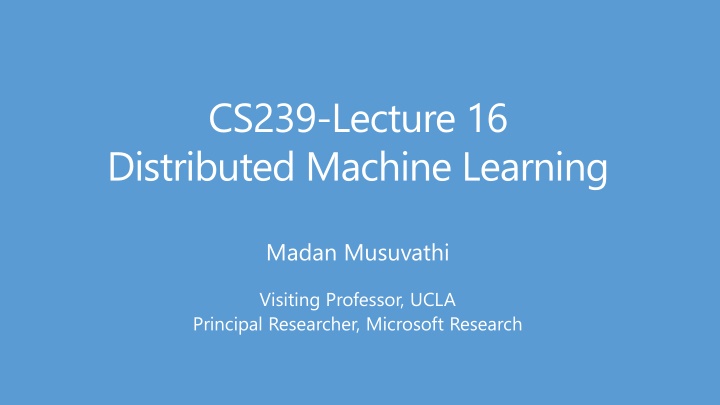
Distributed Machine Learning for Deep Networks and Model Parallelism
Explore the world of distributed machine learning with a focus on large-scale deep networks and model parallelism. Discover the challenges and innovations in scaling deep learning models, such as DistBelief's asynchronous gradient computation and two-level parallelism methods. Learn how model parallelism enables training across machines via message passing and within a machine using multithreading. Uncover the future of model training and the quest for efficiency with large datasets.
Download Presentation

Please find below an Image/Link to download the presentation.
The content on the website is provided AS IS for your information and personal use only. It may not be sold, licensed, or shared on other websites without obtaining consent from the author. If you encounter any issues during the download, it is possible that the publisher has removed the file from their server.
You are allowed to download the files provided on this website for personal or commercial use, subject to the condition that they are used lawfully. All files are the property of their respective owners.
The content on the website is provided AS IS for your information and personal use only. It may not be sold, licensed, or shared on other websites without obtaining consent from the author.
E N D
Presentation Transcript
CS239-Lecture 16 Distributed Machine Learning Madan Musuvathi Visiting Professor, UCLA Principal Researcher, Microsoft Research
Course Project Write-ups due June 1st Project presentations 12 presentations, 10 mins each, 15 min slack Let me know if you cannot stay till 10:15
DistBelief: Large Scale Distributed Deep Networks Presented by Liqiang Yu 05.23.2016
Background & Motivation Deep learning has shown great promise in many practical applications Speech Recognition Visual Object Recognition Text Processing
Background & Motivation Increasing the scale of deep learning can drastically improve ultimate classification accuracy Increase the number of training examples Increase the number of model parameters
The limitation of GPU Speed-up is small when the model doesn t fit in the GPU memory Data and parameter reduction aren t attractive for large scale problems(e.g. high-resolution image) MapReduce, GraphLab New distributed framework needs to be developed for large scale deep network training
DistBelief Allow the use of clusters to asynchronously compute gradients Not require the problem to be either convex or sparse Two novel methods : (1) Downpour SGD (2) Sandbalster L-BFGS Two level parallelism : (1) Model Parallelism (2) Data Parallelism
Model Parallelism Machine
Model Parallelism Model DistBelief enables model parallelism (1)Across machines via message passing(blue box) (2)Within a machine via multithreading(orange box) Machine (Model Partition) Core Training Data
Whats next ? Model Training is still slow with large data sets if a model only considers tiny minibatches (10-100s of items) of data at a time. How can we add another dimension of parallelism, and have multiple model instances train on data in parallel? Training Data
Data Parallelism Downpour SGD Sandblaster L-BFGS Parameter server
Downpour SGD A variant of asynchronous stochastic gradient descent Divide the training data into a number of subsets and run a copy of the model on each of these subset Update the derivatives through a centralized parameter server Two asynchronous aspects : model replicas run independently and parameter shards run independently
Downpour SGD p = p+ p p = p + p Parameter Server p p p p Model Data
Downpour SGD p = p+ p Parameter Server p p Model Workers Data Shards
Downpour SGD Each model replica computes its gradients based on slightly out of date parameters No guarantee that at any given moment each shard of the parameter server has undergone the same number of updates Subtle inconsistencies in the timestamps of parameters Little theoretical grounding for the safety of these operation, but it works!
Adagrad learning rate ? ??,?= ? 2 ?=1 ??,? Adagrad can be easily implemented locally within each parameter server shard ??,? is the learning rate of the ith parameter at iteration K ??,? is its gradient ? is the constant scaling factor Adagrad learning rate becomes smaller during the iteration, which increases the robustness of the distributed models.
Sandblaster L-BFGS Coordinator (small messages) Parameter Server Model Workers Data
Compare SGD with L-BFGS Async-SGD first derivatives only many small steps mini-batched data (10s of examples) tiny compute and data requirements per step at most 10s or 100s of model replicas L-BFGS first and second derivatives larger, smarter steps mega-batched data (millions of examples) huge compute and data requirements per step 1000s of model replicas
Conclusions Downpour SGD works surprisingly well for training nonconvex deep learning models Sandblaster L-BFGS can be competitive with SGD and easier to scale to larger number of machines Distbelief can be used to train both modestly sized deep networks and larger models.
Distributed Parameter Server Mu Li et al. OSDI 2014
Machine learning Given (??,??) learn a parametrized model ? ? ?,? ? is the parameters that we want to learn Large scale: Datasets can range between 1 TB to 1PM Parameter sizes: 1B to 1T
This paper A generic framework for distributing ML algorithms Sparse logistic regression, topic modeling (LDA), sketching, The system abstracts Efficient communication through asynchrony and consistency models Fault tolerance Elasticity What other system we have studied is this the most similar to?
Flexibility Asynchronous tasks & dependency Requires sophisticated vector clock managment Consistency: BSP > bounded delay > complete asynchrony





















